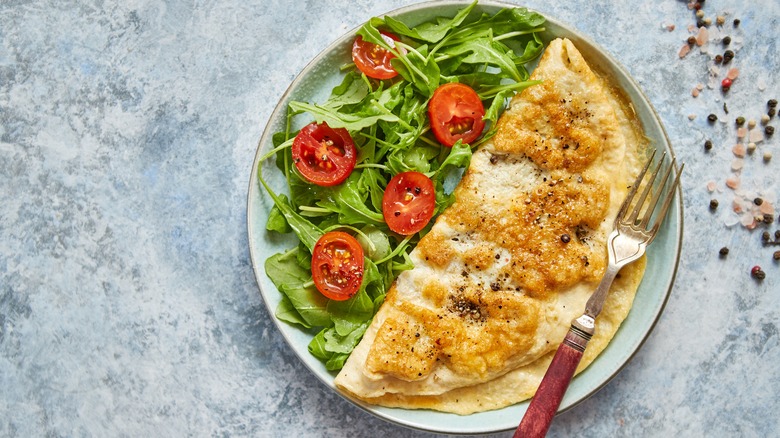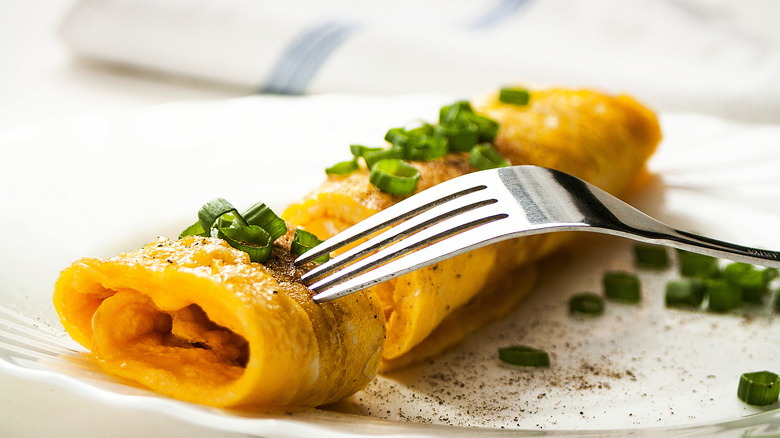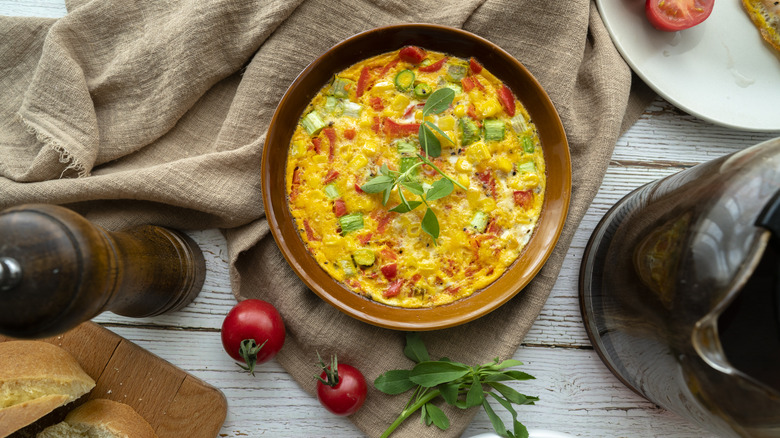What's The Difference Between A Frittata And An Omelet?
Eggs may be one of the most versatile foods on earth, so it's no surprise that there are hundreds of ways to dress them up — and as many names to call the resulting dishes. Omelets are a common way to prepare eggs; most people might say they have had an omelet in their lifetime. Frittatas are less common, but are occasionally encountered when brunching. But, what is the difference between an omelet and frittata? Think of an omelet as a sleeping bag for delicious fillings like vegetables and cheese, while frittatas are more like an egg tart.
To be more specific, both omelets and frittatas are made with beaten eggs, but when it comes to cooking and presenting them, they're quite different. You fold your ingredients into an omelet, creating a kind of pouch for cheese, bacon bits, or anything you like. To make a frittata, you're creating something that more resembles a crustless tart rather than an eggy pouch.
The omelet has been around for quite some time
Omelets have been with us for a long time: They first appeared in 14th century France, but the concept can be traced back to even ancient Rome. Just about every culture has their own take on it, from Japanese tamagoyaki and omurice to Julia Child's French omelet. People everywhere seem to love folding veggies, cheese, and meat into fluffy eggs. (It's a bit of a no-brainer, too, as eggs and milk are quite the power couple.)
The beautiful thing about this dish is that there are endless variations and possibilities — if you can fold it into a beaten egg mixture, you can call it an omelet. Heck, you don't even need any filling to make one, really.
The version most people recognize more closely resembles Child's French omelet; folded fluffy eggs in butter with an herb garnish. This dish isn't difficult, but there is definitely a technique to making the perfect French omelet. For starters, it requires a couple of eggs whisked with milk (or water) to create volume and texture.
The real trick, however, is the method of cooking; one of the more common challenges of getting it right is folding the filling inside. The weight of your ingredients may tear them, or you can run the risk of unevenly cooking your omelet, leaving it burned on one side and raw on another. It takes a bit of practice to perfect the dish, but it's a critical cooking skill to have.
What exactly is a frittata?
Frittata means "fried" in Italian, so you can guess how this dish is prepared. The frittata is essentially a quiche without the crust, but not dissimilar to an omelet — especially in that they're relatively quick and easy to make. Frittata preparation typically takes a bit longer than an omelet, but requires little technical skills. It's packed with filling, largely due to its open-faced presentation. The dish resembles a Spanish tortilla (though not the flour kind made for tacos), and a frittata is not cooked on the stove like an omelet, but rather baked (like its cousin the quiche).
The core preparation in frittatas and omelets are similar: You whisk eggs with a little liquid, usually milk or cream. But with a frittata, instead of folding the ingredients into the eggs, you essentially make an egg pie by pouring the beaten goods over your cooked filling. Once the eggs are in the skillet, pop the whole thing into the oven to set. This method allows you to use many more eggs, ensures even cooking, and prevents a burned bottom.
Unlike an omelet, a frittata is a great dish to make for a big crowd because, well, there's more of it and it doesn't have to be eaten right away. Simply slice it up like you would a pie, serve hot with an herby garnish, and refrigerate whatever's left (if there is any at all).


